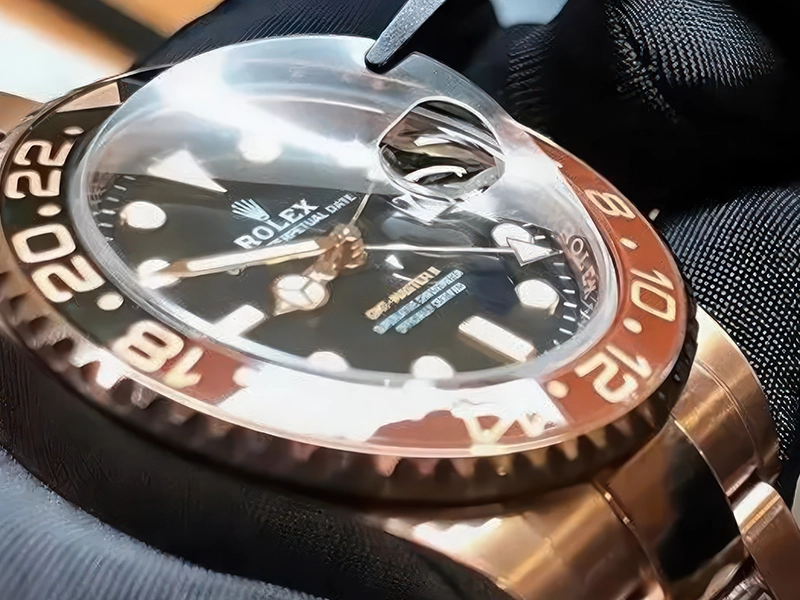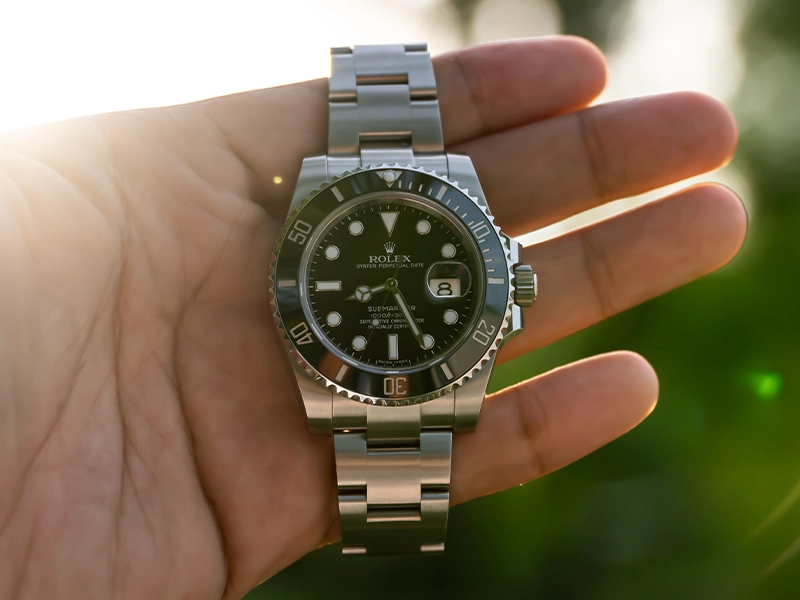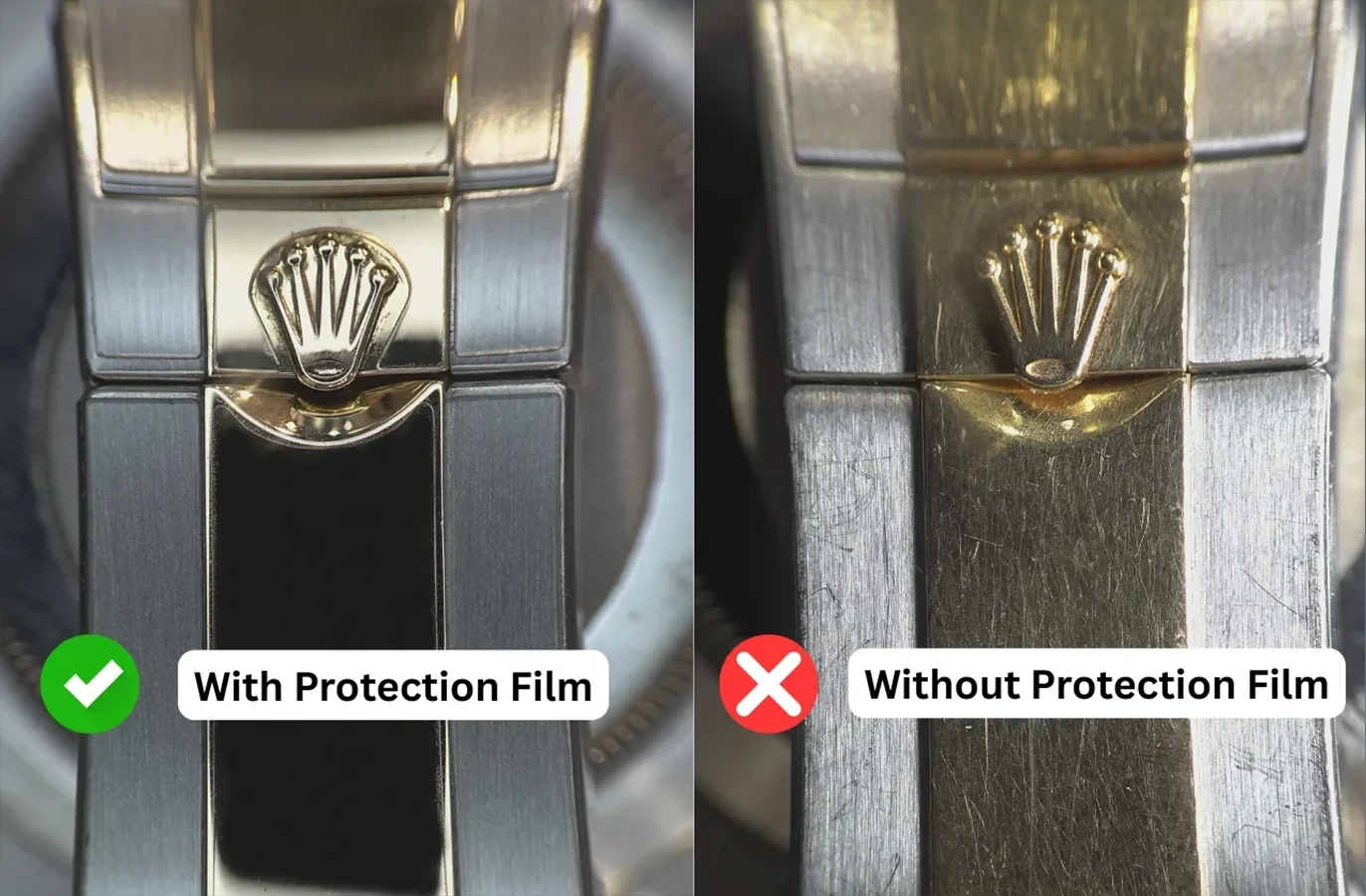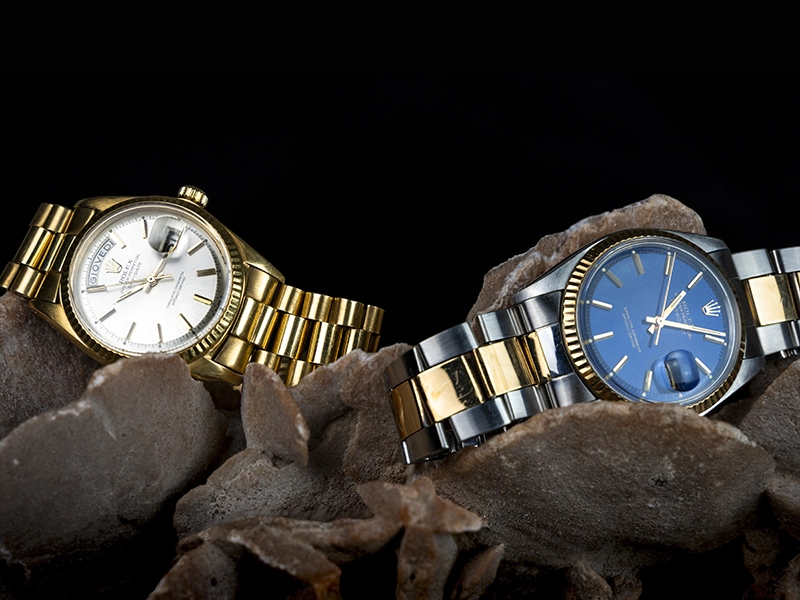It starts with perfection—a Rolex, Patek Philippe, or Richard Mille. Every polished edge and gleaming surface radiates timeless craftsmanship and prestige. But no matter how gently you wear it or how carefully you store it, the inevitable happens: a faint scratch on the bezel, a subtle scuff on the crystal, or a mark on the mirror-finish caseback. Small imperfections—but on a timepiece like this, they feel enormous.
To shield their timepieces from these everyday blemishes, many collectors and enthusiasts turn to protective films—ultra-clear, precision-cut layers designed to preserve the beauty of their watch. One of the most intriguing claims surrounding these films in recent years? Self-healing technology.
But how real is this claim? Can these films actually heal themselves from scratches, or is it just another marketing gimmick?
Let’s dive into the science, technology, and truth behind luxury watch protection films that promise to self-repair.
What are watch protection films?
Watch protection films are ultra-thin, crystal-clear layers engineered to shield your luxury timepiece from everyday wear and minor damage. Typically made from high-quality polyurethane (PU) or thermoplastic elastomers (TPU/TPE), these flexible yet durable materials offer excellent transparency, abrasion resistance, and in many cases, added benefits like UV protection and hydrophobic (water-repelling) properties.
Each film is laser-cut to seamlessly cover and protect key areas of the watch, including:
- Bezel
- Crystal
- Case sides and lugs
- Caseback
- Clasp and bracelet links

By forming a nearly invisible barrier, these protective films help maintain the watch’s original finish, prevent fine scratches and scuffs, and preserve its resale value, especially on highly polished or delicate surfaces that are more prone to visible damage.
Whether worn daily or stored in a collector’s case, a well-applied protection film offers peace of mind without compromising the look or feel of your timepiece.
What is “self-healing” technology in protection films?
Self-healing films are made from advanced, high-performance materials that can repair minor scratches and swirl marks over time, often with little to no intervention. While it may sound futuristic, this technology is very real and has been proven across multiple industries.
Thermoplastic polyurethane (TPU), a common material in these films, was originally developed to protect helicopter blades during wartime due to its flexibility and impact resistance. Today, it’s widely used in automotive paint protection, consumer electronics, and even in the biomedical field for its durability, safety, and adaptability.
At the heart of this innovation is a specialised elastic polymer layer designed to “reform” at a molecular level when exposed to heat. Here’s a closer look at how it works:
The science behind it
Micro-repairable surface layer: The outermost layer of the film has viscoelastic properties, meaning it can absorb small abrasions and gradually return to its original smooth surface.
- The top two layers provide surface protection and scratch resistance
- The middle two layers serve as shock absorbers, cushioning the watch from minor impacts
- The bottom two layers are adhesive, ensuring secure attachment while remaining removable without residue
Heat activation: When stimulated by body heat, warm water, or indirect sunlight, the polymer molecules gain enough mobility to shift and fill in shallow scratches, effectively erasing them from view.
Not a miracle cure, but impressive: While these films can’t heal deep gouges, tears, or damage that penetrates the surface, they excel at correcting light wear, such as micro-scratches from fingernails, shirt cuffs, or casual contact with hard surfaces. In many cases, these marks fade or disappear completely within minutes to hours.
In essence, self-healing protection films act like a reset button for minor surface damage, helping your watch maintain a flawless appearance with less worry and maintenance.
Three self-healing film technologies
Not all watch protection films are created equal, and when it comes to self-healing technology, material composition really matters. Here are the most common types of self-healing films used to protect luxury timepieces:
1. Thermoplastic Polyurethane (TPU) films
The most widely used material in premium watch films, TPU is known for its:
- High flexibility and optical clarity
- Moderate self-healing ability for minor surface scratches
- Resistance to UV rays, water, and general wear
TPU strikes a balance between protection and subtlety, making it a go-to option for daily wear.
2. Nano-coated films
These advanced films are enhanced with nanotechnology, offering:
- Improved heat sensitivity, allowing scratches to fade more quickly
- Superior transparency for an almost invisible finish
- Faster self-repair, often without the need for heat activation
Nano-coated films are ideal for users who want a high-tech, low-maintenance solution.
3. Hybrid films
A newer generation of protection films, hybrids combine the best of several technologies:
- TPU base layers fused with ceramic coatings or hydrophobic treatments
- Exceptional durability and gloss retention over time
- Some variants offer self-healing even at room temperature, no extra heat needed
These films are engineered for long-term protection and aesthetic preservation, especially on watches with mirror-polished or high-touch areas.

What can these films actually heal from?
While self-healing technology is impressive, it’s important to keep expectations grounded in reality. These films are designed to handle everyday wear, not catastrophic damage.
What they can heal:
Self-healing films are highly effective at recovering from:
- Light hairline scratches caused by routine handling
- Micro-abrasions from shirt cuffs, gloves, or cleaning cloths
- Swirl marks from casual surface contact or friction
These minor imperfections typically fade or disappear over time, especially with gentle heat from body warmth, warm water, or ambient sunlight.
What they can’t fix:
Despite their flexibility, self-healing films are not indestructible. They will not repair:
- Deep scratches or gouges that penetrate through the surface
- Punctures from sharp objects
- Tears, peeling, or delamination of the film itself
- Damage that reaches the watch surface beneath the film
Think of self-healing protection films as a smart buffer layer—capable of absorbing and correcting minor blemishes, but not meant to withstand extreme impact or neglect. They’re a powerful tool for maintaining a flawless appearance, but not a substitute for mindful wear and care.
Care tips to maximise self-healing performance
To get the most out of your watch protection film — and ensure its self-healing properties remain effective — a little care goes a long way. Here are some best practices:
1. Use gentle heat to encourage healing:
For minor surface scratches, try applying warm (not hot) water or allow body heat to naturally activate the film. Lightly buffing the area with a clean microfiber cloth can help the process along.
3. Protect from excessive heat exposure:
While gentle heat aids healing, extreme temperatures, like open flames, direct heat sources, or prolonged sun exposure, can cause warping, discolouration, or premature film failure.
2. Avoid harsh chemicals and abrasives:
Stay away from toxic substances like cologne, perfume, and sunscreen, as these can tarnish the film over time and cause yellowing. Also, avoid alcohol-based cleaners, solvents, or abrasive cloths, as they can degrade the self-healing layer and dull the film’s clarity.
4. Know when to replace the film:
No film lasts forever. If you notice peeling, permanent scratches, cloudiness, or reduced adhesion, it’s time for a replacement. Depending on your usage and environment, most films last 1 to 3 years.

The verdict: Can protective films truly self-heal?
Yes — but within limits. High-quality luxury watch protection films can self-heal from light surface scratches, swirl marks, and micro-abrasions, often within hours and with minimal heat exposure. This impressive feature helps maintain a flawless appearance through regular use.
However, it’s important to remember: self-healing doesn’t mean indestructible. These films won’t repair deep scratches, punctures, or damage that penetrates the film, nor can they reverse harm already done to the watch itself.
If you’re someone who values keeping your timepiece looking box-fresh, a premium self-healing film is a wise investment, especially when combined with careful daily wear and proper maintenance. It’s a subtle layer of protection that delivers real peace of mind.
Modern armour for classic timepieces
Luxury watches are far more than accessories — they’re symbols of craftsmanship, legacy, and personal style. Whether passed down through generations or proudly worn on your wrist, these timepieces deserve to be protected with care.
While the occasional scratch may be inevitable, modern self-healing film technology offers an elegant solution. These ultra-clear, intelligent films provide a nearly invisible shield that helps your watch withstand everyday wear, without compromising its appearance or character.
No, they won’t make your watch indestructible. But they do add a smart, effective line of defence that keeps your timepiece looking pristine, extending its beauty and value for years to come.
So the next time you take your prized watch out for a dinner, a meeting, or a casual stroll, you can do so with confidence and peace of mind, knowing that those little scuffs are no longer permanent guests.


